Tropical suppliers to Europe’s wood flooring sector are being squeezed out as domestic production in the region is rising again, oak is becoming increasingly dominant, and competition from laminated flooring and other non-wood materials is mounting.
The European Federation of the Parquet Industry (FEP) reports that European wood flooring production (not including laminate flooring) was 78.0 million m2 in 2015, 3.6% more than in 2014. This included gains of 2.6% to 64.0 million m2 in the 17 countries covered by FEP[1] and 3.6% to 14.6 million m2 in other EU countries that are not members of FEP. Despite gains every year since 2009, production is still 20% down on the peak of 98.3 million m2 in 2007. (Chart 1).
[1] Austria, Belgium, Czech Republic, Denmark, Finland, France, Germany, Hungary, Italy, Netherlands, Norway, Poland, Romania, Slovakia, Spain, Sweden and Switzerland.
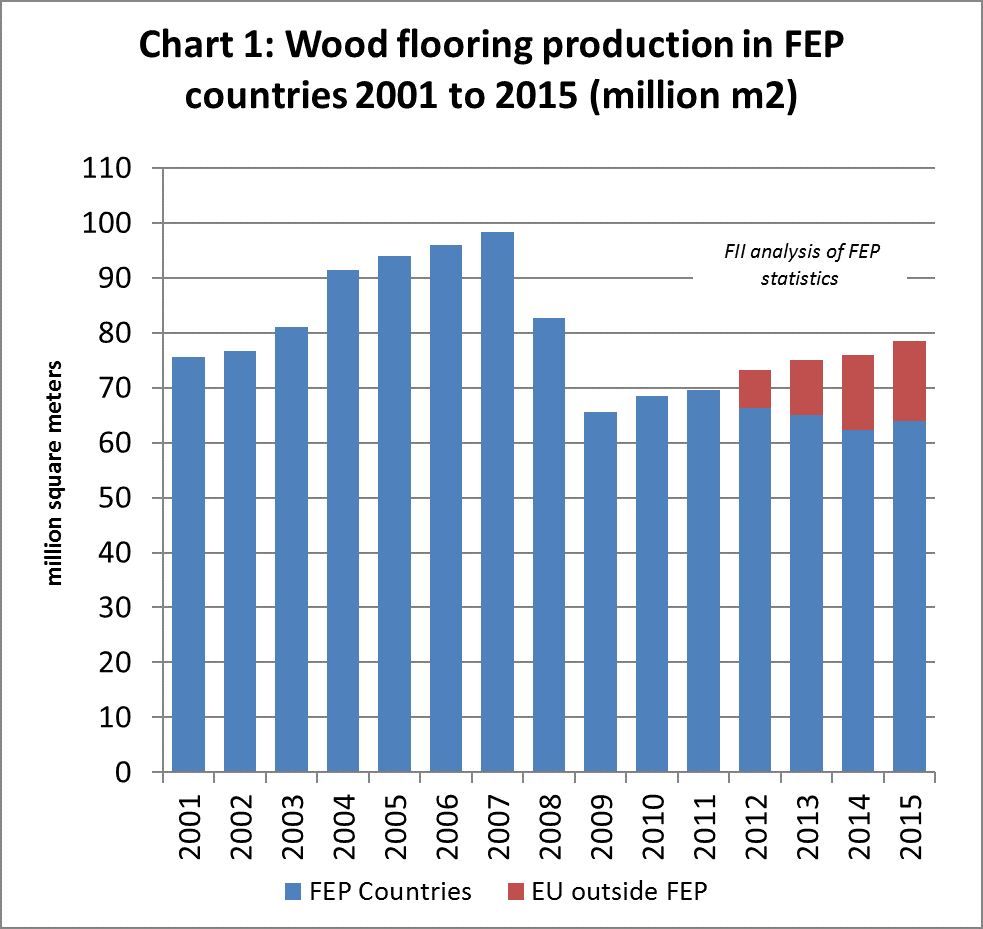
Amongst FEP member countries, significant production gains were made in Sweden (+15%), Spain (+10%), and Italy (+4%) during 2015. Production declined in Poland and Germany and was flat in Austria, France, and Romania. (Chart 2).

Oak-faced flooring accounted for 78% of all wood flooring manufactured in Europe in 2015, up from 60% in 2008. The major loser has been tropical hardwood, which has seen its share of wood flooring produced in Europe fall from 14.7% in 2008 to only 4.5% in 2015. In 2015, ash was the second most widely used species for facing wood floors (5.6%), followed by beech (3.8%) and walnut (1.4%). All other species accounted for less than 1% (Chart 3).

In 2015, multilayer parquet floors accounted for 84% of wood floors manufactured in Europe, the majority comprising three-layer parquet (roughly 70 % of total market volume). Solid wood flooring accounted for only 14% of production.
The rise in European production in 2015 was stimulated by an increase in domestic consumption. For the first time since the onset of the global financial crisis, southern European markets for hardwood flooring, particularly Spain, gained momentum in 2015 and this trend continued in the first half of 2016. The rise in European production in 2015 was partly at the expense of imports which lost market share during the year.
The EU’s large trade deficit in EU wood flooring that opened up before the financial crises, driven by the housing bubble and a flood of product from China, has narrowed sharply in recent years. In 2015, EU wood flooring imports from non-EU countries fell 5.4% to 28.17 million m2. Meanwhile EU exports to non-EU countries fell only slightly in 2015 and are rising again in 2016 (Chart 4).
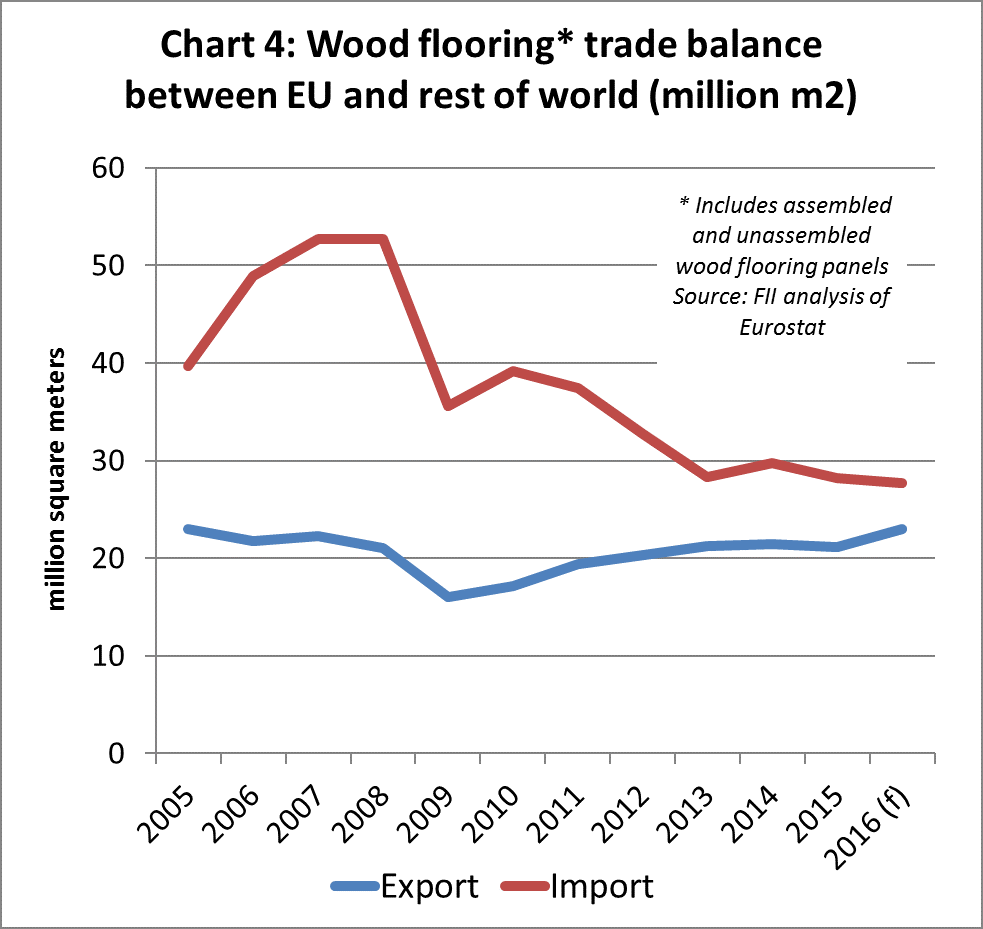
Chinese wood flooring losing share in Europe
Imports of wood flooring from China, by far the EU’s largest single external supplier of this commodity, suffered a set-back in the EU market in 2015 falling 7.4% to 17.3 million m2, the lowest level since 2005. The downward trend has continued this year, with a further 9% fall to 7.9 million m2 in the first 6 months of 2016. (Chart 5).
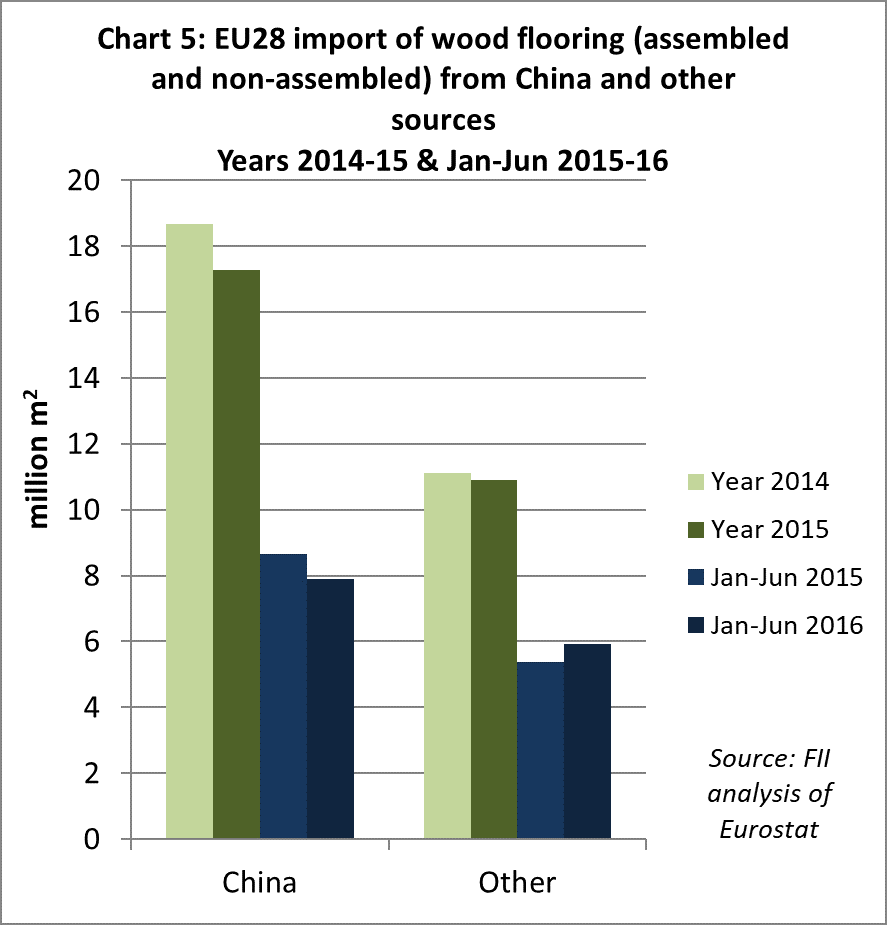
To some extent the decline in EU imports of wood flooring from China in 2016 has been offset by rising imports from other countries. However, all the gains made in the EU market in 2016 have been by temperate countries and no tropical country has benefited from China’s loss of market share. In the first half of 2016, EU imports of wood flooring were significantly higher than the same period in 2015 from Ukraine (+50% to 1.98 million m2), Switzerland (+40% to 0.69 million m2), and Bosnia (+26% to 0.58 million m2). Imports declined from Indonesia (-8% to 0.69 million m2), Malaysia (-19% to 0.52 million m2), Brazil (-13% to 0.32 million m2) and Vietnam (-33% to 0.18 million m2). (Chart 6).
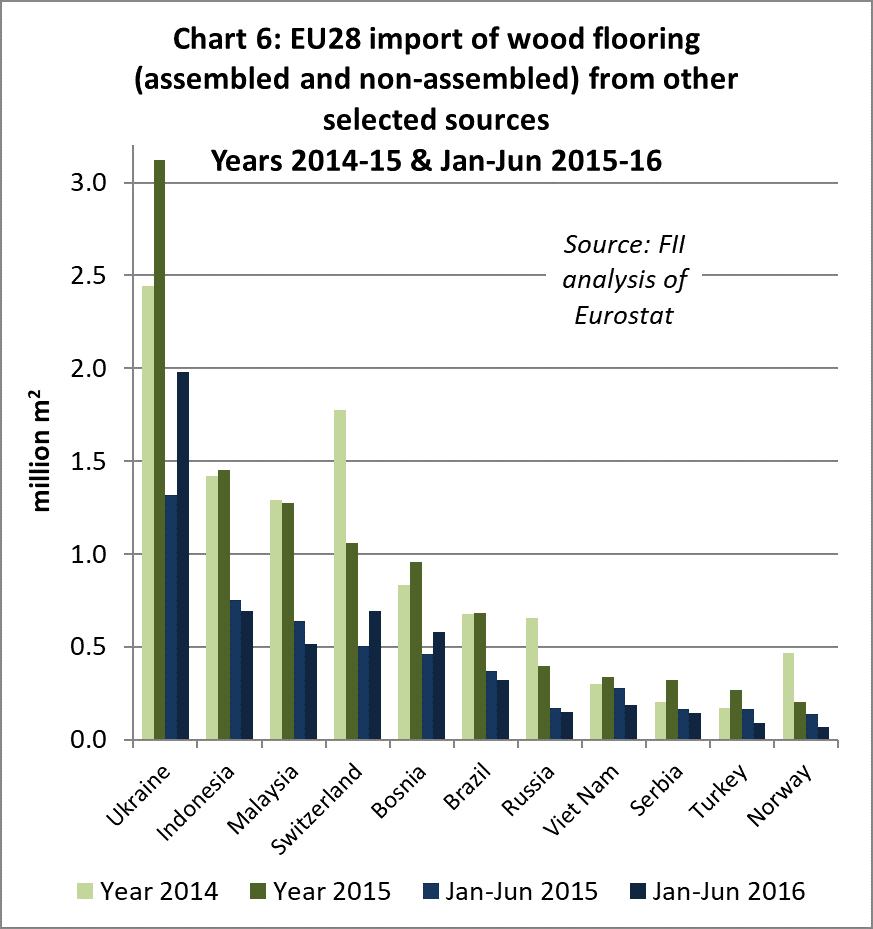
The destination for wood flooring imports into the EU is also changing in 2016. Imports into the UK, the largest destination for Chinese flooring products, declined 9% to 2.7 million m2 in the first six months of 2016. Wood flooring imports have also weakened into the Netherlands, Sweden and France this year. However there has been a sharp increase in imports into Poland, the main destination for Ukrainian flooring products (Chart 7).

Wood flooring faces stiff competition in the European market from laminates and non-wood materials. According to FEP “it is becoming increasingly difficult for consumers to differentiate parquet from competitive flooring alternatives with a wood look surface.” Members of the European Producers of Laminate Flooring (EPLF) association sold 452 million m2 of laminate flooring in 2015, around 333 million m2 of which was in Europe, over four times the volume of wood-faced flooring consumed in the region. Competition from non-wood materials is also intense and varies between countries. For example, the challenge comes particularly from luxury vinyl tiles (LVT) in Germany and from ceramic tiles in Italy.
EU wood flooring exports rising again in 2016
After five years of continuous growth between 2009 and 2014, EU wood flooring exports declined slightly in 2015, by 1.7% to 21.1 million m2. However, growth resumed in the first six months of 2016, with exports rising by 9% to 11.2 million m2. The downward trend in exports to Switzerland and Norway in 2015 was reversed in the first six months of 2016 (Chart 8).
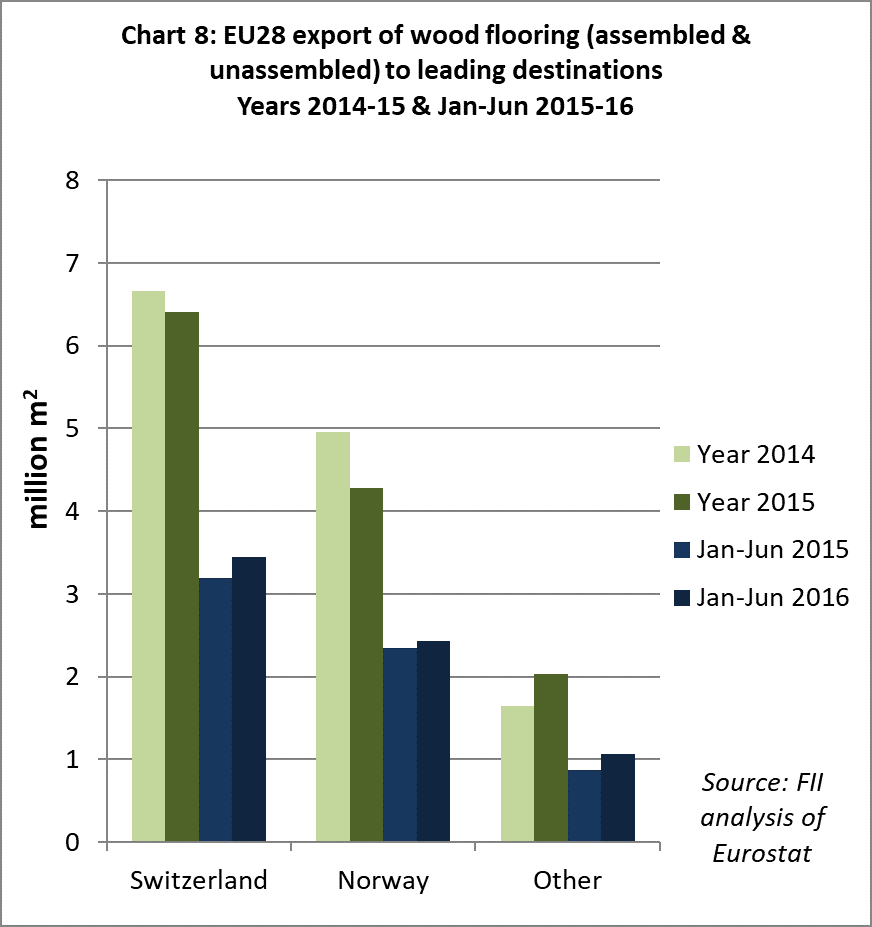
After making significant gains in 2015, EU wood flooring exports continued to increase rapidly to the USA (+23%) and China (+154%) in the first six months of 2016. However, some of the gains made by EU wood flooring products in the Turkish and Canadian markets in 2015 were lost during the first half of 2016. Exports also declined to Russia during the same period. (Chart 9).
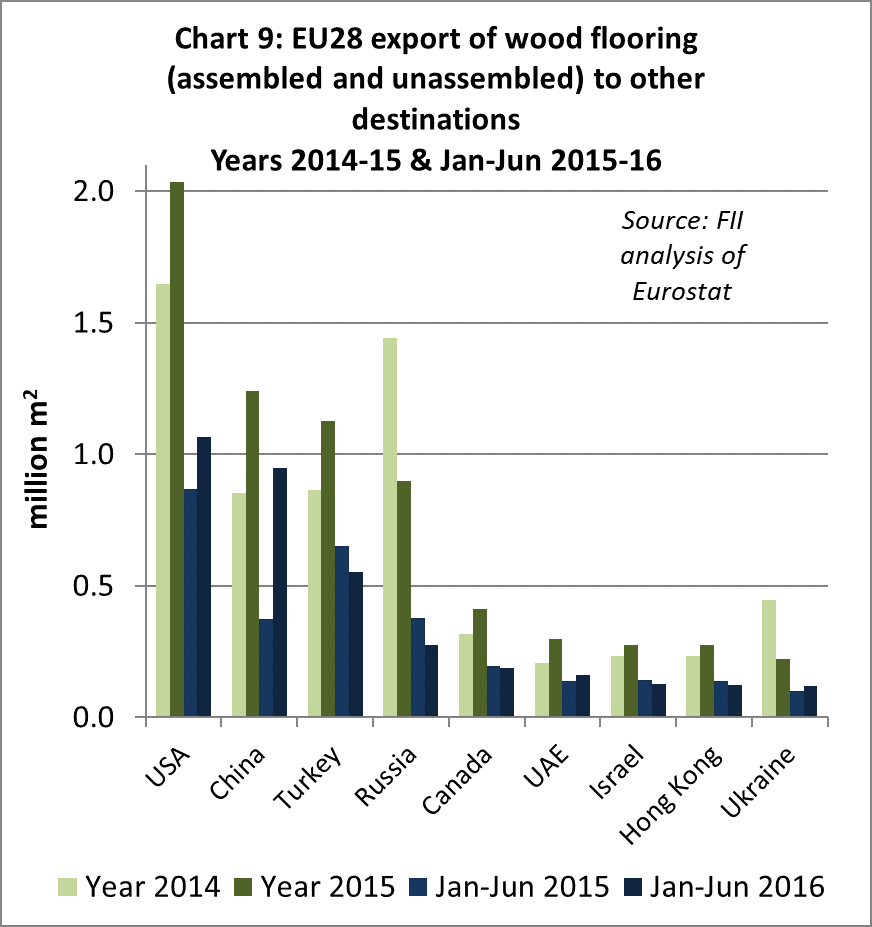
In summarising their latest market statement, published in June 2016, FEP were reasonably positive about future prospects for Europe’s wood flooring sector. They noted that “after several years of hardship for the European Parquet Producers and the overall negative developments in both consumption and production, the sky has cleared somewhat. EU economic indicators point towards a continuation of a slightly positive trend and the generally encouraging reports received from a majority of FEP member countries fuel the hope for better times ahead”.
These observations clearly apply to the domestic industry as current trade trends suggest that opportunities both for imports of finished flooring, and for tropical materials to supply European manufacturers may be narrowing. However, FEP also make some observations which suggest some potential for imported materials. FEP observed that “from previous detailed marketing surveys conducted by FEP, we know that parquet has a very high desirability coefficient. It is sustainable, made from a renewable raw material and should be valued as a long-term investment”. Furthermore, FEP expressed concern about “the raw material supply situation (especially for oak)”.
For tropical suppliers, the combination of restricted local availability of oak, and the strong focus on demonstrating sustainability through commitment to FSC labelling and FLEGT licensing, offers potential to open up new opportunities in this market – although this would require significant commitment to market development in a very crowded and competitive sector.
PDF of this article:
Copyright ITTO 2020 – All rights reserved

